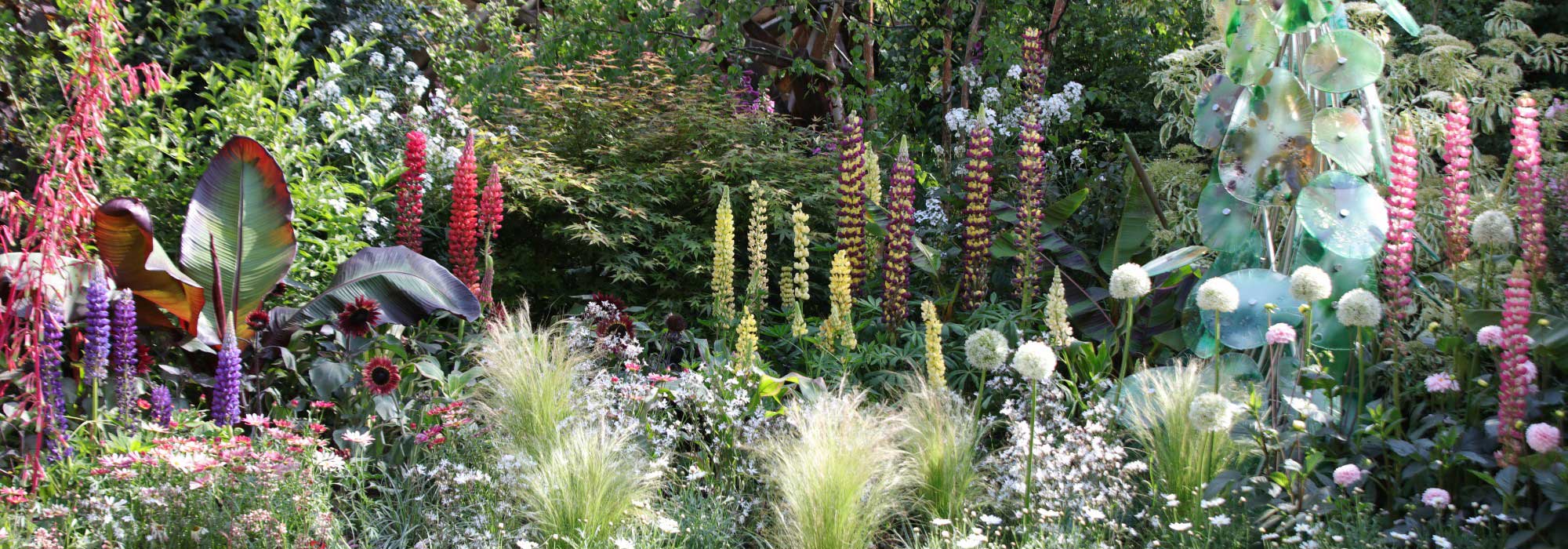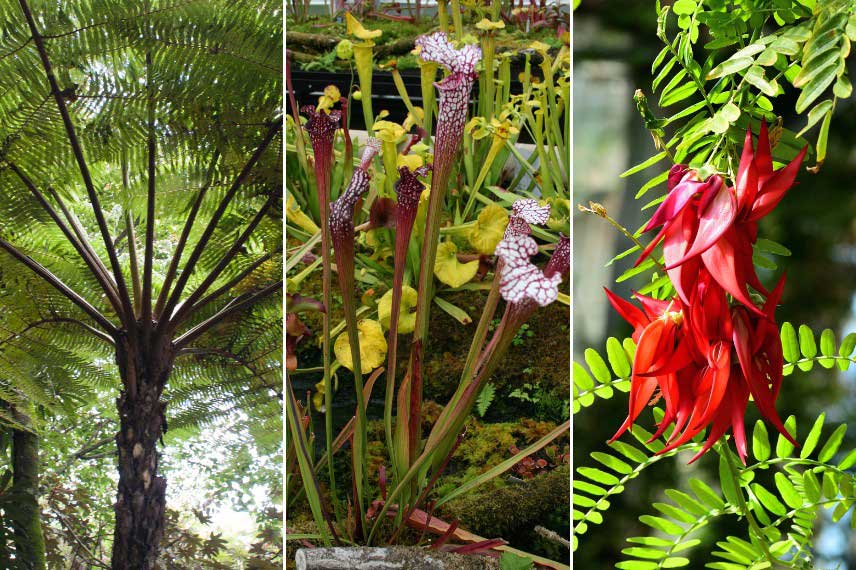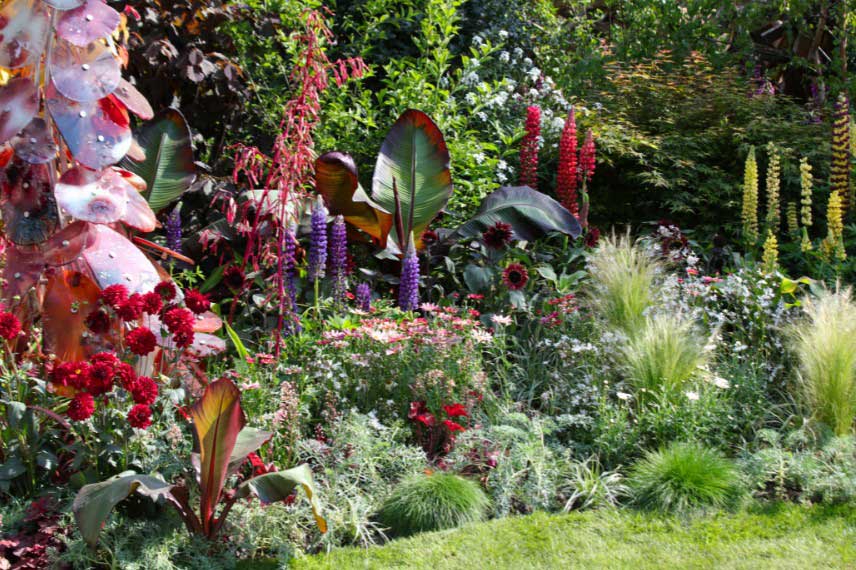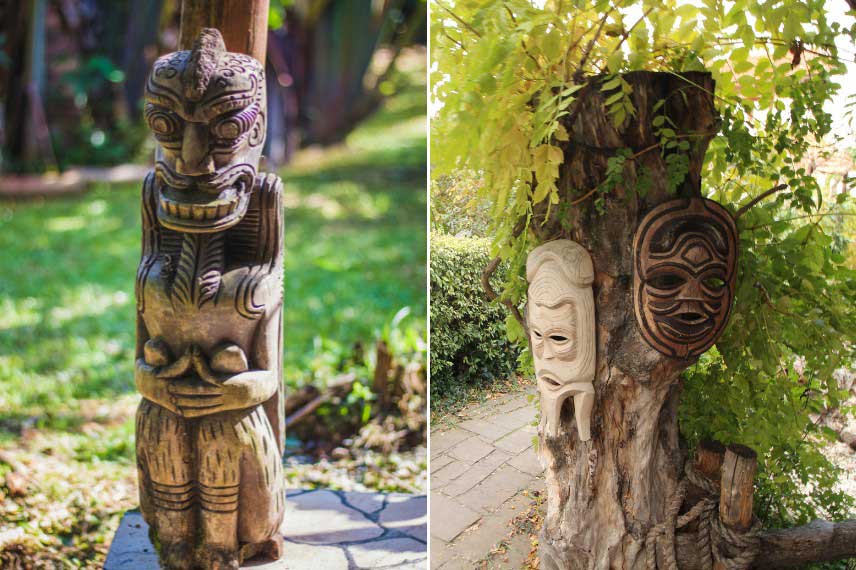
Dreamlike Eden: The Most Immersive Garden Trend of 2025
The garden as a dreamlike refugium
Contents
Exuberant, theatrical and utterly immersive, the fantasy Eden garden is set to be one of the major trends of 2025. Halfway between primal nature and natural utopia, it conjures up dense, almost supernatural vegetation, playing with contrasts, emotions and the uncanny. This is a free-spirited, intense garden-refugium, filled with hybrid forms and unsettling atmospheres. Whether you wish to transform your entire garden or simply design a secluded corner, this style reconnects us with imagination and mystery. Discover how to create your own Eden with our selection of exuberant and phantasmagorical plants!
The world of the imagined Garden of Eden
The garden reaffirms a deep desire to reconnect with simple emotions. In this era of polycrisis, it satisfies the longing for a regressive, immersive refugium. In search of a return to a more primal nature, we yearn for a free, abundant setting conducive to contemplation and wonder. At the height of the fantasy of a lost paradise, a fascination emerges for natural chaos, with its surprises, excesses, and imbalances.
Banana trees with oversized foliage, carnivorous plants with unsettling beauty, lupins standing like totems, and spectral flowerings recreate a jungle with utopian overtones. This vegetation shapes a fantasised Garden of Eden, a key trend for 2025, where nature expresses itself in all its exuberance, even flirting with the surreal. Densely planted and teeming, the garden forms a jungle fed by excess and symbolism. It adorns itself with tropical foliage, contrasting textures, and saturated colours. Grasses become tousled, almost wild, adding movement to this theatrical plant world. Here, nature is staged, caught between a primitive, almost prehistoric vision and a dreamlike projection. This contrast between the raw and the artificial gives rise to an immersive cocoon where we sense both the primal power of nature and its potential post-human evolution.
Man becomes a spectator in a world where nature dreams of itself—amplified, sometimes unrecognisable, always fascinating.
This garden is populated by hybrid forms, unusual textures, and plant “creatures.” One easily encounters chimerical sculptures that extend this aesthetic of strangeness. These enigmatic presences blur the boundary between the real and the imagined, the living and the artificial. An invitation to lose oneself, to marvel differently.

The Fantasised Eden Garden combines plants with luxuriant foliage, such as the tree fern Cyathea cooperi, carnivorous plants like Sarracenia leucophylla, and plants with strange and original flowerings, such as Clianthus puniceus
Read also
How to design a tropical garden?How to interpret it in your garden?
Borders become denser, edges blur, giving way to an intentional profusion, almost jungle-like. This style invites layering foliage, combining suppleness with rigid structures, and mixing glossy and matte textures, soft and rough. Lines disappear in favour of shifting plant masses, where each plant seems to emerge spontaneously.
Think in layers, in successive depths: in the foreground, place spreading, dense foliage like colocasias, asarum, or coleus with unexpected colours.
At the centre, focus on structural flowering: lupins standing like totems, compact dahlias, the glowing stem of a Beschorneria yuccoides amidst a green palette or velvety-textured celosias. In the background, let powerful silhouettes emerge—red Abyssinian bananas, tetrapanax, tall bonesets, ‘Honolulu’ castor bean, or even a tree fern—to anchor the scene in vertical greenery.
Alternate shapes: the upright stems of ornamental alliums rise between the soft undulations of a stipa or the delicate quivering of a moluccella. Slide between these strata with foliage of more archaic appearance, like that of pseudopanax. Introduce a vivid splash, a rough texture, an ambiguous silhouette—anything that disrupts the conventional reading of a border.
A simple contrast in heights, a bold foliage placed to start a perspective, or a break in the rhythm of plant arrangement is enough to create visual tension. Let a more sculptural plant draw attention in a shaded area. The key is not strict design, but the sensation of moving through a living, strange, almost autonomous world.
The colour palette of the imagined Garden of Eden
The colour palette of this theatrical garden is both intense and nuanced. It doesn’t seek tame harmony but rather a sensory awakening. It oscillates between deep, almost dramatic hues and luminous bursts that capture the light, soothing and bringing subtle balance to the whole. Reds dominate the scene, in a wide range of tones. The deep reds of the flowering establish a dramatic, almost velvety base, softened by the coppery tones of certain foliage. In contrast, the electric blues or purples of lupins bring an enigmatic, almost surreal freshness. Their upright spikes add a spectral presence to the garden, like so many plant silhouettes emerging from a dream.
A few touches of pure white act as a breath, a luminous pit in this saturated composition.
Grasses with wild, untamed forms, like stipa, infuse a sense of effervescence and complete this dreamlike Bizarretum. Bushes with shifting foliage, such as the redbud, add a painterly dimension to this chromatic composition. It’s a palette that evokes both the lushness of an ancient world and the vibrant accents of a dream yet to come. This controlled explosion of hues is jointed around intense, contrasting colours, blending brilliance and mystery. Here are the main tones that define the aesthetic of this imagined Eden garden:
- Garnet red and deep purple: dramatic shades that create a dense, enchanting atmosphere.
- Electric blue and saturated violet: vibrant bursts that infuse an almost supernatural energy.
- Bright yellow and soft pink: luminous accents that bring touches of freshness amidst the plant density.
- Pure white: a visual pit, it soothes without dulling and captures the light like a breath of air.
- Greens and coppery tones: they create a shifting backdrop and intensify the impression of lushness.

The chromatic palette for creating an “Imagined Eden” ambience: garnet red and dark purple, electric violet, and touches of bright yellow, soft pink, and white
Which plants for a fantasised Garden of Eden?
To bring a dreamlike Eden to life, every plant must evoke emotion: surprise, fascination, sometimes even a slight unease. Think in terms of presence, mystery, and controlled extravagance. This garden thrives on plants with bold presence and intriguing textures. It calls for singular essential oils, chosen for their strange beauty, theatrical habit, or their ability to evoke distant lands. Here’s a selection to create a dense, immersive, and dreamy setting:
- Spectral flowerings: Lupins ‘Gallery‘, ‘La Chatelaine’, ‘Mon Chateau’ and ‘West Country Manhattan Lights’, Ornamental onion ‘Mont Blanc’, Tricyrtis hirta, Amaranth.
- Dramatic flowerings: Dahlia ‘Mini Balle Maroon Fox’ and ‘Brown Sugar’, Celosia ‘Fan Dance Purple’, Sunflower ‘Desire Red’, Canna ‘Red Wine’ and Common castor bean ‘Honolulu’.
- Enigmatic flowers: Tigridia pavonia ‘Aurea’, Eucomis ‘Octopus’, Asarum, Clianthus puniceus ‘Kaka King’ and Molucella laevis ‘Bells of Ireland’, carnivorous plants.
- XXL foliage: Sikkim banana, Abyssinian red banana, Giant honey flower, Colocasia, Fatsia japonica and arborescent ferns.
- Plant architectures: Beschorneria yuccoides, Pseudopanax ‘Bronze Eagle’ and Quercus petraea ‘Insecata’.
- Pictorial foliage: Eastern redbud ‘Eternal Flame’, Coleus ‘Flame Thrower Chili Pepper’, Coleus ‘Skeletal’ and ‘Ruffles Copper’.
- Delicate plants: Stipa tenuifolia and Boneset ‘Elegant Plume’.

A few plant ideas to create a Dreamlike Eden atmosphere: Lupin ‘West Country Manhattan Lights’, Ornamental onion ‘Mont Blanc’, Amaranthus ‘Velvet Curtains’, Ensete ventricosum ‘Maurelii’, Moluccella laevis and Stipa tenuifolia
Perfect the decor
In a fantasised Eden garden, the scenography doesn’t stop at plantings. The setting is enriched with elements that deepen immersion into this dreamlike and disorienting universe.
Underfoot, moss, black gravel or deconstructed stepping stones enhance the impression of a garden sprung from a dream—wild yet sacred. To create this reinvented world, which unfolds in a gentle tension between the familiar and the imagined, one must craft a setting that is both botanical and sculptural, futuristic-organic.
Scatter here and there totemic forms inspired by living things: assembled branches, imaginary trees resembling mutant organisms, or biomorphic silhouettes shaped from wood or stone. Neither fully plant nor entirely figurative, they rise amidst the foliage as if nature itself had sculpted its own idols. These sculptures echo the forms of spectacular plants—upright lupins, sprawling foliage, carnivorous inflorescences. Their lines draw from growth, the organic, the living. They might emerge at the edge of a grove, appear half-hidden among leaves, or form symbolic thresholds. The idea is to sow doubt: is it a tree? A creature in mutation?
The whole does not seek clarity. This garden seems inhabited by botanical memory, yet also by an intuition of what nature might become.

Don’t hesitate to incorporate decorative elements such as wood or stone totems and sculptures
- Subscribe!
- Contents
































Comments